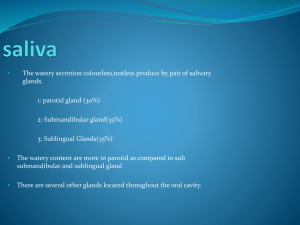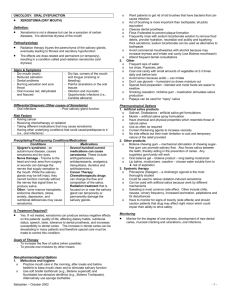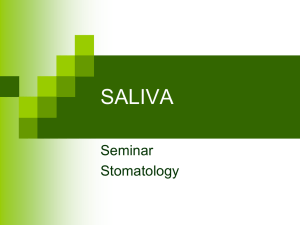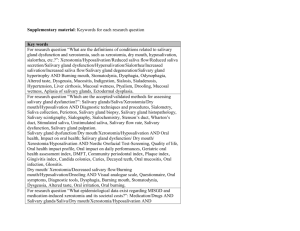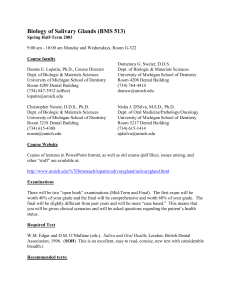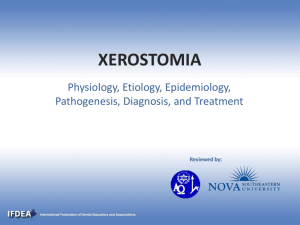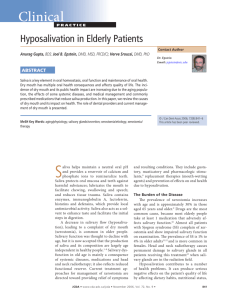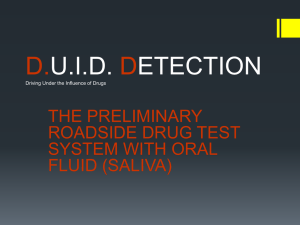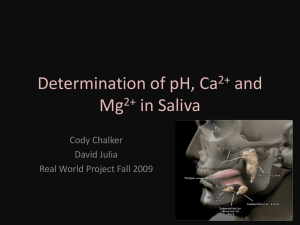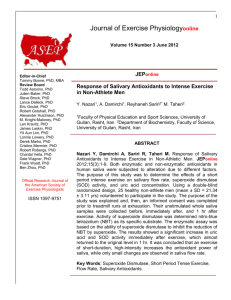xerostomia project
advertisement
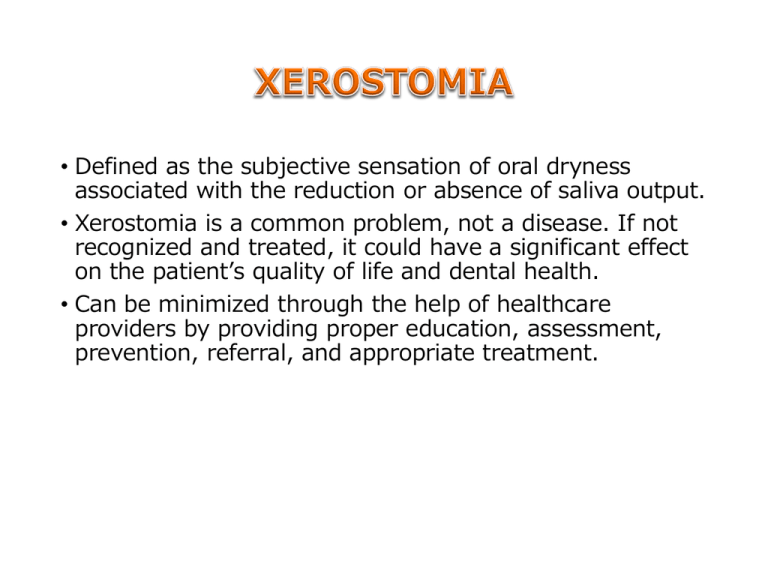
• Defined as the subjective sensation of oral dryness associated with the reduction or absence of saliva output. • Xerostomia is a common problem, not a disease. If not recognized and treated, it could have a significant effect on the patient’s quality of life and dental health. • Can be minimized through the help of healthcare providers by providing proper education, assessment, prevention, referral, and appropriate treatment. MENOPAUSE • Permanent sensation of menstruation resulting from the loss of ovarian functions. • Occurs between 42 to 56 years of age; usually around age 51, when the ovaries discontinue egg production and estrogen levels decline. • Estrogen levels decline rapidly during menopause, which leads to systemic bone less. RELATIONSHIP BETWEEN XEROSTOMIA AND MENOPAUSE • During menopause, changes in hormone levels affect the salivary glands; often leaving menopausal and postmenopausal women with a persistent feeling of dryness in the mouth. • Low un-stimulated saliva flow rate correlates with the severity of xerostomia in menopausal women. • Testosterone level in saliva and serum of menopausal women with xerostomia is significantly higher. • Menopause can bring oral health problems in the same processes that lead to loss of bone in the spine and hips can lead to loss of alveolar bone of jaws resulting: • Periodontal disease. • Loose teeth. • Tooth loss. Whole Saliva Flow Rates (ml/min) NORMAL FLOW RATES ABNORMAL FLOW RATES UNSTIMULATED (RESTING) WHOLE SALIVA 0.3-0.4 ml/min <0.1 ml/min STIMULATED WHOLE SALIVA 1-2 ml/min <0.5 ml/min *Whole saliva is the total output from the major (parotid + submandibular + sublingual) and minor salivary glands. Factors That Affect Salivary Flow • Drugs/Medication • Irradiation • Systemic Diseases • Auto-Immune Diseases • Hormonal Imbalance • Aging • Stress/Anxiety/Depression Signs • Difficulty speaking or swallowing. • Altered taste. • Complaint of dryness. • Complaint of burning mouth, lips and/or tongue. • Altered olfactory. • Frothy saliva. • Absence of saliva. • Gingivitis. Symptoms • Increased Caries • Cracking and fissuring of tongue or lips. • Food sticking to the oral structure. • Ulceration of oral mucosa. • Poorly fitting prostheses. • Sore throat/Commissure sore • Reduced oral pH causing erosion. Normal Functions for Saliva Hydrating – Moisturizing Cleansing Lubrications Digestion Remineralization of dentition (pH maintenance, and buffering) • Maintenance of mucosal integrity • Immunity mediator • Antimicrobial (antifungal, and antibacterial) • • • • • • Stimulation of minor salivary gland • Cellular maintenance • Enables swallowing • Enables tasting • Enables speech articulation Anti-Microbial Factors in Human Whole Saliva Non-Immunoglobulin Factors 1. Lysozyme 2. Lactoferrin 3. Salivary peroxidase (SCN-/H2O2) 4. Myeloperoxidase (CL5. Agglutinins, aggregating proteins 6. Histidine-rich polypeptides 7. Proline-rich proteins Immunoglobulin Factors 1. Secretory IgA 2. IgA, IgG, and IgM Role of Health Care Provider and Home Care • Ask: Identify and document severity of xerostomia for every patient with menopause. • Process: Salivary glands biopsies specialized studies such as MRI and CT. • Elimination or reduction of select drugs. • Substitution of one drug for another with less noxious effects. • Prescribe artificial saliva or saliva substitutes can be used to replace moisture and lubricate mouth. Goals: • Alleviating symptoms • Instituting preventive measures • Treating existing oral condition • Improving salivary function • Managing underlying systemic condition • Healthy diet • Habit modification • Based on the results of Farzaneh Agha-Hosseini, and his co-researchers, low salivary flow, high serum and salivary testosterone, and low femur bone mineral density are associated with the perception xerostomia in menopausal women. • This study was supported by the Dental Research Center, School of Dentistry, Tehran Tehran University of Medical Sciences. The figure below shows their findings between healthy women and women with xerostomia. . Fig. 1. Concentrations of testosterone in serum, stimulated, and un-stimulated saliva of women with or without xerostomia. *P< 0.01. Data are presented as means ± SEM. Agha-Hosseini F, Mirzaii-Digzah I, Mahdieh-Sadt, M. DDS, . Salivary flow, testosterone, and femur bone mineral density in menopausal women with oral dryness feeling. Vol.115 No. May 5, 2013 References 1. Farzaneh Aggha-Hosseini,Iraj Mirzaii- Dizgah. Unstimulated whole saliva parathyroid hormone in postmenopausal xerostomia. The journal of contemporary dental practice,May-June ,2011:12(3) : 196-199 women with 2. Agha-Hosseini F, Mirzaii-Dizgah I, Mirjalili N. Relationship of stimulated whole saliva cortisol level with the severity of a feeling of dry mouth in menopausal women. Gerodontology 2010 3. Cathy L. Bartels, Pharm. D., assistant professor, pharmacy, School of Pharmacy and Allied Health Sciences, University of Montana. http://www.oralcancerfoundation.org/dental/xerostomia.htm 4. Agha-Hosseini F, Mirzaii-Dizgah I, Moghaddam PP, Akrad zT. Stimulated whole salivary rate composition in menopausal women with oral dryness feeling. Oral Dis 2007; 13:320-3. 5. Agha-Hosseini, Mirzaii-Dizgah, Mahdieh- Sadat M. Salivary flow, testosterone, and femur bone mineral density in menopausal women with oral dryness feeling. Oral Dis. 2013; 2212-4403. 6. http://www.oralhealthnet.co.uk/admin/wp-content/uploads/2011/07/XEROSTOMIA.jpg 7.http://images.rheumatology.org/image_dir/album75673/md_09-11-0015.jpg 8. http://www.oralhealthnet.co.uk/admin/wp-content/uploads/2011/07/XEROSTOMIA.jpg 9. http://www.dental--health.com/images/badteeth/mountain_dew_damage.jpg 10. http://www.nhs.uk/Conditions/dry-lips/PublishingImages/dry-cracked-lips_342x198_C0018629.jpg 11. http://www.drdeanlodding.com/blog/wp-content/uploads/2011/05/5693284147_894f88b4c1_b.jpg 12. http://www.periowaveblog.com/tag/xerostomia-treatment/.
